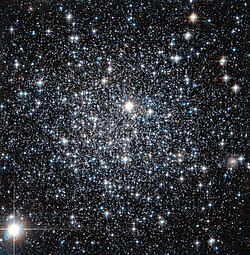IC 4499
| IC 4499 | |
|---|---|
 | |
| Pozorovací údaje (Ekvinokcium J2000,0) | |
| Typ | kulová hvězdokupa |
| Objevitel | DeLisle Stewart[1] |
| Datum objevu | 1901[1] |
| Rektascenze | 15h 00m 18,57s[2] |
| Deklinace | -82°12′49,6″[2] |
| Souhvězdí | Rajka (lat. Aps) |
| Zdánlivá magnituda (V) | 9,76[3] |
| Úhlová velikost | 7,6'[4][1] |
| Vzdálenost | 61 300 ly[3][1] |
| Fyzikální charakteristiky | |
| Absolutní magnituda (V) | -7,32[3] |
| Metalicita [Fe/H] | −1,15 |
| Označení v katalozích | |
| Jiná označení | GCl 30,[4][5] |
| (V) – měření provedena ve viditelném světle | |
| Některá data mohou pocházet z datové položky. | |
IC 4499 je kulová hvězdokupa v souhvězdí Rajky na jižní obloze. Nachází se ve středně vzdáleném galaktickém halu asi 50 000 světelných let od Země. Objevil ji americký astronom DeLisle Stewart roku 1901. Její hvězdná velikost je 10,6 a je zajímavá tím, že podle její úrovně metalicity je mladší než okolní kulové hvězdokupy; její stáří je asi 12 miliard let. Na obloze se nachází v jihozápadní části souhvězdí, 3 stupně jižně od hvězdy α Muscae s magnitudou 2,7.
Související články
Reference
V tomto článku byly použity překlady textů z článků IC 4499 na anglické Wikipedii a IC 4499 na německé Wikipedii.
- ↑ a b c d SEDS NGC Catalog Online: Results for IC 4499 [online]. [cit. 2016-07-07]. Dostupné online. (anglicky)
- ↑ a b SIMBAD Astronomical Database: Results for IC 4499 [online]. [cit. 2016-07-07]. Dostupné online. (anglicky)
- ↑ a b c Harris, W.E. A Catalog of Parameters for Globular Clusters in the Milky Way. S. 1487. Astronomical Journal [online]. Říjen 1996 [cit. 2016-07-07]. Roč. 112, s. 1487. Dostupné online. doi:10.1086/118116. Bibcode 1996AJ....112.1487H. (anglicky)
- ↑ a b The NGC/IC Project: Results for IC 4499 [online]. [cit. 2016-07-07]. Dostupné v archivu pořízeném dne 2009-05-28. (anglicky)
- ↑ SLOTEGRAAF, Auke. Deep Sky Observer's Companion: IC 4499 [online]. [cit. 2016-07-07]. Dostupné online. (anglicky)
Externí odkazy
 Obrázky, zvuky či videa k tématu IC 4499 na Wikimedia Commons
Obrázky, zvuky či videa k tématu IC 4499 na Wikimedia Commons - Simbad – IC 4499
- IC 4499 na stránkách DOCdb (Deep Sky Observer's Companion)
Média použitá na této stránce
Autor: Credit: ESA/Hubble & NASA, Licence: CC BY 3.0
IC 4499: A globular cluster’s age revisited
This new NASA/ESA Hubble Space Telescope image shows the globular cluster IC 4499.
Globular clusters are big balls of old stars that orbit around their host galaxy. It has long been believed that all the stars within a globular cluster form at the about same time, a property which can be used to determine the cluster's age. For more massive globulars however, detailed observations have shown that this is not entirely true — there is evidence that they instead consist of multiple populations of stars born at different times. One of the driving forces behind this behaviour is thought to be gravity: more massive globulars manage to grab more gas and dust, which can then be transformed into new stars.
IC 4499 is a somewhat special case. Its mass lies somewhere between low-mass globulars, which show a single generation build-up, and the more complex and massive globulars which can contain more than one generation of stars. By studying objects like IC 4499 astronomers can therefore explore how mass affects a cluster's contents. Astronomers found no sign of multiple generations of stars in IC 4499 — supporting the idea that less massive clusters in general only consist of a single stellar generation.
Hubble observations of IC 4499 have also helped to pinpoint the cluster's age: observations of this cluster from the 1990s suggested a puzzlingly young age when compared to other globular clusters within the Milky Way. However, since those first estimates new Hubble data been obtained, and it has been found to be much more likely that IC 4499 is actually roughly the same age as other Milky Way clusters at approximately 12 billion years old.
Credit:
ESA/Hubble & NASA
About the Object
Name: IC 4499
Type: • Milky Way : Star : Grouping : Cluster : Globular
• X - Stars Images/Videos
Distance: 55000 light years
Colours & filters Band Wavelength Telescope
Optical V 606 nm Hubble Space Telescope WFC3 Infrared I 814 nm Hubble Space Telescope WFC3.
